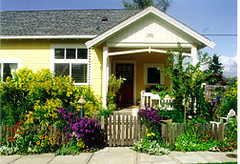The case for living small

Posted August 16, 2010 at 12:14PM
Frequent readers probably know that the ever-provocative, Miami-based architect (and, I would argue, philosopher) Steve Mouzon is on my short list of Other Writers Who Make Me Think. His latest Original Green post does not disappoint, juxtaposing an intriguing comparison between what Steve calls ‘the poverty of large’ and ‘the luxury of small’: when we reduce our range, Steve posits, we are better able to improve and enjoy the things on which we focus.
One can make an argument that the statement applies to a lot more than architecture. But, in this case, we’re discussing home sizes.
Steve puts it better than I can:
“Our condo is 747 square feet, as opposed to the 3,000 square feet of [Steve’s previous home]. The countertops are soapstone instead of the big house’s cheapest possible white ceramic tile on plywood. The kitchen walls are pleated stainless steel instead of the sheetrock of the big house. I could go on, but you get the idea. Did we suddenly hit the lottery? Not at all. The reason we were able to finish the condo out so much better was because there simply wasn’t that much of it. Because everything was smaller, everything could be better. Small is the new luxury. Without being this much smaller, we’d have never lived in a place this much better.”
 The familiar statistics are there in the post, confirming what those of us with eyes have witnessed over the last several decades. Much as with cars, meal portions, and supermarkets, Americans’ average home size has been increasing dramatically even as our average household size has been getting smaller (with empty-nesters and singles claiming a larger share of the housing market relative to households with children). The post continues:
The familiar statistics are there in the post, confirming what those of us with eyes have witnessed over the last several decades. Much as with cars, meal portions, and supermarkets, Americans’ average home size has been increasing dramatically even as our average household size has been getting smaller (with empty-nesters and singles claiming a larger share of the housing market relative to households with children). The post continues:
“All that over-consumption came at a great price. Once, buildings were built for the ages. At the Meltdown, construction quality had become so shoddy that pieces of houses could regularly be found falling off in the driveway in less than ten years! We had become a nation of throw-away buildings and throw-away places. Obviously, we can never become sustainable if we keep throwing stuff away like this . . .
“Houses that have to be built as cheaply as possible because they’re being built as large as possible aren’t really worth saving. And so when the too-big maintenance bill on the too-big house hits too soon because it was built too cheaply to last very long, the easy answer is to discard it and start over somewhere else. And so the throw-away cycle continues.”
There’s a lot more to the post, including great photos, as always with The Original Green. Go here and see for yourself. (And, for a take on how living small can be translated into small-community infill, see this post on Langley, Washington's Third Street Cottages, photo above left.)
Move your cursor over the images for credit information.

